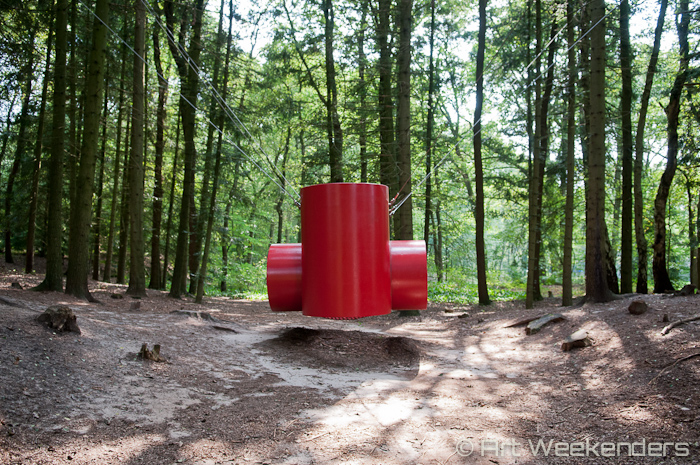An Art Day at the Kröller-Müller Museum
The first week of the month means a new occasion for the ArtSmart Roundtable, a monthly series of articles by a group of art focused travel bloggers. This month the theme is ‘an art day’ and our experience is coming from the Kröller-Müller Museum in the east of Holland, a venue out of the ordinary. Don’t forget to check out all the great contributions from the other bloggers from this month – listed at the bottom of the article. Enjoy!
What if we told you that you can spend a day among close to a hundred Van Gogh original paintings and a few thousand other famous modern art works of great importance from a wide range of different “isms”? Still not enough you say? What about later in the day (or earlier, if you so prefer) a stroll around one of Europe’s biggest open-air sculpture parks, with some fascinating pieces located in lush nature, and then rounding off the day with a bike around in one of the nicest national parks of Europe? Does that sound like an ideal suggestion for a daytrip? We certainly think so. All this and a bit more is waiting for the visitor at one of the the hidden secrets of the Netherlands, at the Kröller-Müller Museum in the east of the country, located in the heart of the Hoge Veluwe National Park, not far from a little town called Otterlo.
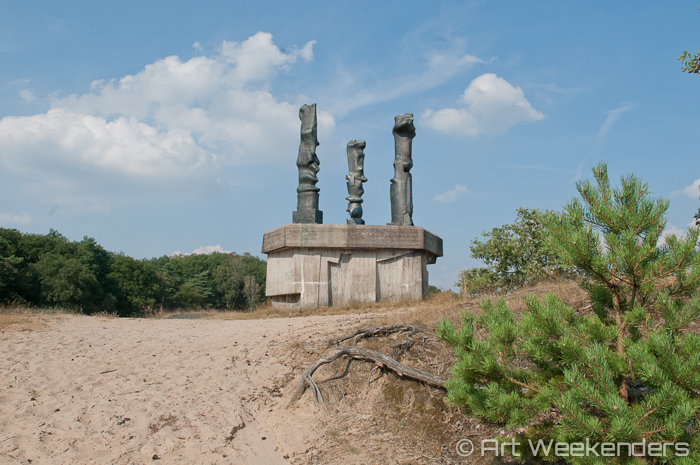
Three upright motives by Henry Moore
On the first day of August, on one of the brilliantly sunny days we’ve recently been spoiled with here on the Dutch latitudes, we visited the Kröller-Müller Museum. A great experience that left us wondering why we didn’t jump on this opportunity earlier. There’s no reason holding back here, already in the opening lines we can admit that this is one of the best spots in Europe to experience art and it’s a spot that most people still don’t know about.
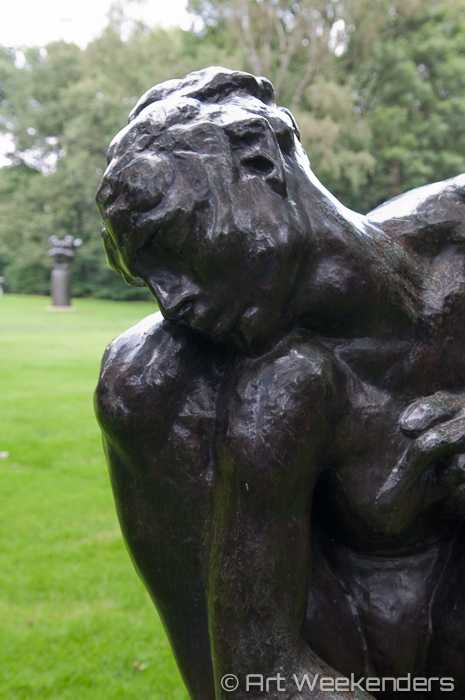
Auguste Rodin, Femme accroupie, 1882
Its location in the east of The Netherlands has a role in it; although this is a small country, it is not just around the corner, even though this “far eastern” part of the country happens to be only some one and a half hours away from the greater Amsterdam area. Still, it feels far and we’re not the only ones who think so: most tourists visiting the country never make it here, it just happens to be off the usual travel maps. Still, things are changing; in 2013 there were some 330,000 people strolling through the museum designed by Henry van de Welde and the adjacent sculpture park. A nice number already, with a huge potential for further growth.

Rietveld Pavilion
The Dutch-German female modern-day “Medici”
In case you are silently wondering who on earth came up with the idea of picking this “isolated” location for an attractive art museum you won’t be the only one. The person behind the idea is in any case Helene Kröller-Müller, the wealthy wife of the Dutch shipping and mining tycoon Anton Kröller. Helene Kröller-Müller was one of the first women in the world to put together a major art collection and in fact the first person in the Netherlands who created a modern art collection of any kind. The choice of location was motivated by her with the following words in 1932:
We decided on this location in view of the fact that in today’s world distance is no longer a problem.
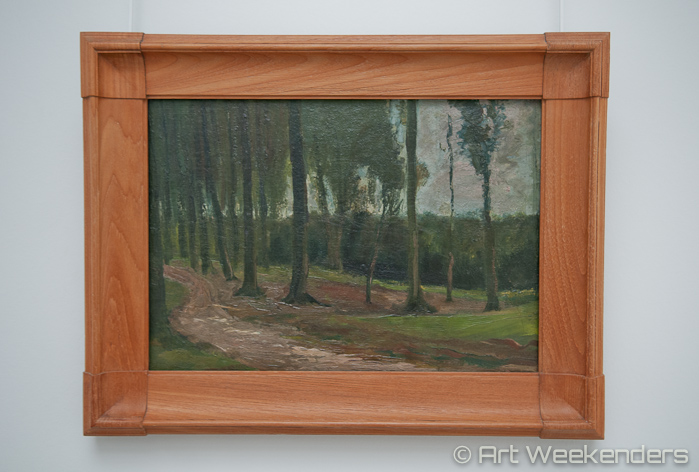
The first Van Gogh bought by Helene Kröller-Müller
She was right in a way; it’s not that complicated getting there, by car at least (public transportation offers some challenges, but see our detailed tips for getting there below). We suspect though that in our busy modern era the lack of time might be a bigger factor impacting on the visitors’ decision-making than the actual distance. In any case, for us who make it there, this is a real treat. Helene Kröller-Müller‘s biggest legacy is undoubtedly the 90 or so Van Gogh paintings and 185 drawings, making this the second largest collection of the artist’s works, second only to Amsterdam’s Van Gogh Museum. The latter is in the possession of more than the double amount of pieces, although it opened some good three decades later, but if you ask us the experience is more special, even intimate, out here “in the woods”.

Love by Joseph Mendes da Costa in the Aldo van Eyck Pavilion
It is often argued that Vincent Van Gogh’s fame never would’ve taken off without the influence of Mrs Kröller-Müller. We’re not here to speculate, but there’s no doubt that the collector had an important role in the after-life fame of the artist’s. It’s no small secret that the Dutch expressionist only managed to sell one work of art during his short and tragic life and the first person who seriously put the artist’s name on the map was Mrs Kröller-Müller.
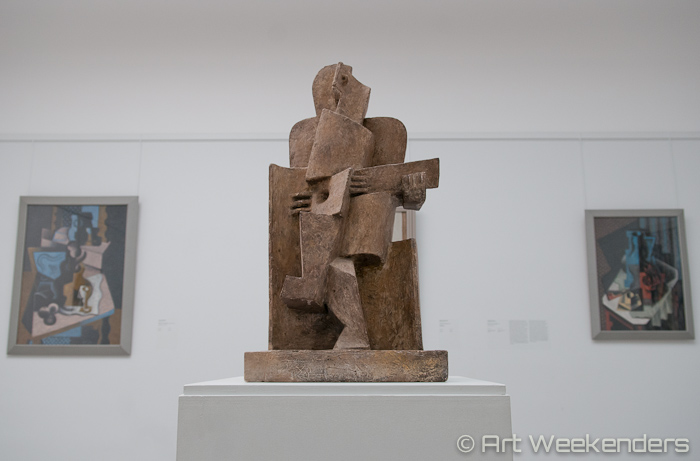
Sitting man with guitar by Jacques Lipchitz.
It wasn’t always that obvious that one day she would be known as an art collector. It was first in her early 40s that she started the project on the initiative of her art tutor Hendricus Petrus Bremmer. Bremmer was a vaguely successful painter in The Hague, where the Kröllers also lived, although his main achievement in life was to realise that he was very good at promoting art to the privileged Dutch elite. On top of it, he was one of the early big fans of Vincent Van Gogh’s and his enthusiasm was contagious on his pupil the enthusiastic Helene too. The collection of the Van Gogh artworks started in the early 1910s and soon enough it became one of the life missions of the collector. The most intense year was by far 1912, when on a visit to Paris seven paintings were purchased in different galleries on the same day and ten more later that month. An extravagant art safari of sorts.
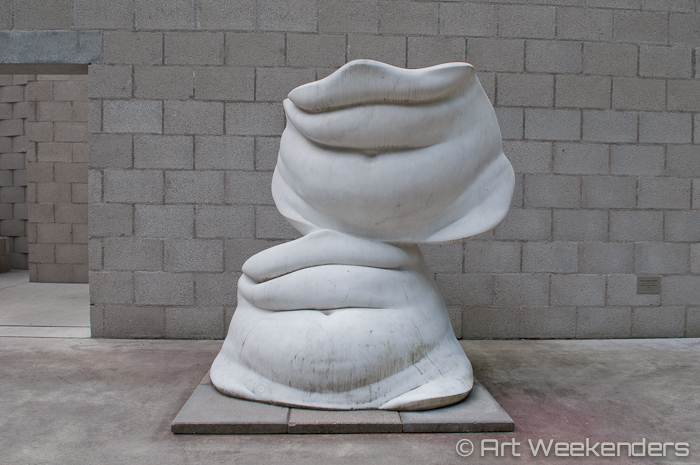
Wielkie brzuchy (Bellies) by Alina Szapocznikow in the Aldo van Eyck Pavilion
It is said that the idea to the museum was born by a visit to Florence and the inspiration the Medicis provided, and the many private collectors showcasing their works around the renaissance city. While the idea was solid from the beginning and many attempts were made to create the museum, the actual realisation of the museum took many years. There was a war that came in between, followed by a financial crisis that almost evaporated the Kröller-Müller empire in the 1920s. At the end the family decided to donate their entire estate to the Dutch government under the condition that a museum would be raised for housing the collections. The chosen location was on the grounds of the Hoge Veluwe Park, which prior to its national park status was the hunting grounds of the Kröller-Müllers.
The Kröller-Müller Museum – The Extended Version
If we fast-forward to our days, the museum we can visit now is quite different from the one that Helene Kröller-Müller left behind. She was only able to be the director of her life’s creation for a bit more than a year before she passed away at the age of seventy in 1939. One of the requirements of hers was that the collection had to be maintained as it was then, no changes were allowed. Her wish has been respected to this day. And built upon.
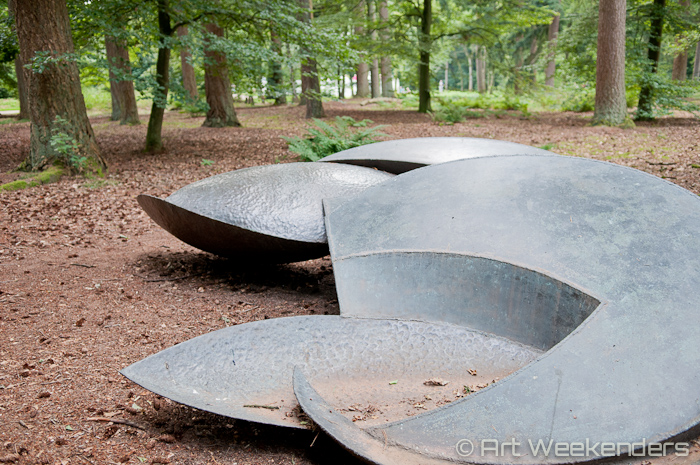
The original plan for the museum included an extended version that finally got realised when the situation in Europe once again stabilised after the war. The museum got a new congress wing and sculpture gallery in 1953 and a whole new wing between 1970 and 1977, specifically made for temporary exhibitions. But the biggest impression-lifter was without any doubt the sculpture garden added in 1961 as the brain-child of the director of the museum from 1947 onwards, the ambitious art critic A. M. Hammacher. His intention of not just sitting around on the legacy of Mrs. Kröller-Müller has made this museum very unique: the combination of world-class paintings with a fantastic sculpture garden is fairly unrivalled in the world.

Hoofdstukken by Jan Fabre
The Sculpture Garden
We came to the Hoge Veluwe on a sunny day, so it felt natural to start our visit out in the open, in the famous sculpture garden of the museum. We expected to spend some time here, just not as much as we actually ended up wandering here. And that’s a very good sign. This is a fantastic spot and it’s easy to conclude that it was a very clever strategic move to “break down” the museum’s walls and extend it into the free. The initial idea of the garden reflected Helene Kröller-Müller’s conception of a symbiosis between art, architecture and nature, a concept well witnessed as soon as you step inside. The garden has expanded over the years and today it includes some 150 objects – and counting.

La Grande Penelope by Emile-Antoine Bourdelle
Since 1961 there has been a steady addition of new works, in fact, to this day the goal is to add at least one new piece every year. The mix of objects is fun and challenging, there are well-known pieces like works by Auguste Rodin, Henry Moore, Jean Dubuffet or Lucio Fontana. There are also many hidden gems, in many ways the highlights out there, like Tom Claassen’s Men in Wood or Kenneth Snelson’s Needle Tower. Or why not Watch Out! by Krijn Giezen, the fun staircase to an infinite heaven (access closed down due to the lure of climbing up to heaven, which easily can result in accidents).

Kijk Uit Attention
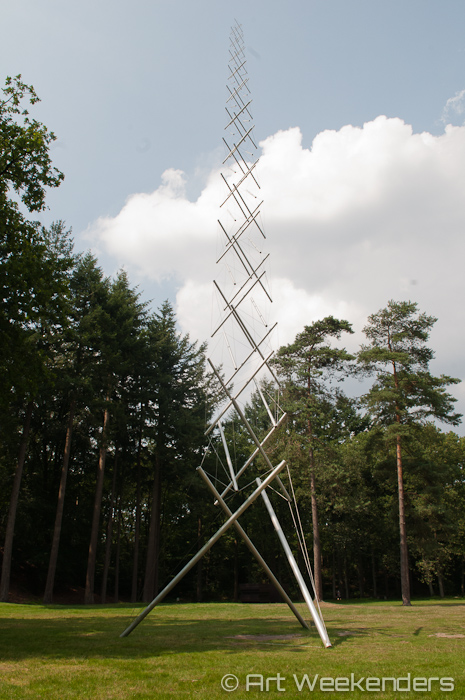
Needle Tower of Kenneth Snelson, 1968
The newly renovated Aldo van Eyck Pavilion – build between 1965 and 1966, rebuilt in 2005 – is also a highlight jam-packed with close to a hundred pieces. Thus, it was no surprise that time flew by, to the extent that we actually had to skip a part of the fun. But more fun was waiting for us inside.
The Van Gogh Collection
We already extended on the subject earlier, but it’s worth repeating: this is the highlight of the museum, with all due respect to the plentiful other highlights around. Fact remains, this is a unique collection and the story of it is fascinating. Some pieces are more than well-known: Café Terrace at Night (1888) has been on almost too many reproductions already. Same goes to for instance Country Road in Provence (1890). Still, there are many that are just not familiar to a broader public, and many which are just fascinatingly beautiful in real life. The darkness of The Potato Eaters (1885) creates an experience that transfixes the viewer. There were also some new-found favourites that in real life turned into real experiences, like the Four Sunflowers Gone to Seed, a surprisingly bright coloured piece among his early works. And hauntingly beautiful.

Four Blown Sunflowers by Van Gogh
A full Range of “isms”
Before and after the Van Gogh Gallery you have the chance to travel through modern art history, there are almost no “ism” here that you can’t find. There are cubism masters like Picasso, Braque. Renoir and Monet from the impressionists. Symbolism, Post-impressionism, pointillism and… no German Expressionism. This later might come as a surprise, Helene Kröller-Müller was after all German by birth and not Dutch, but the collector famously considered the German painters as “insufficiently authoritative”. A hint for her disapproval with the development in that corner of Europe?

L’ homme qui marche II by Alberto Giacometti.
At the far end of the wing housing the permanent collection, after you passed the numerous works by the likes of Fantin-Latour, Seurat, Signac, Cézanne and the hundreds of works by Dutch artist Bart van der Leck you reach another important section of the museum, especially from Dutch perspective: the room where the Mondrian’s and his peers can be seen – Helene was one of the first in the country who recognised the greatness of the Dutch master and the abstract art they represented.
The Wing Housing Great Temporary Exhibitions
If there’s one criticism we can come up with is the fact that the museum closes at five pm. Nothing unusual with that, it’s normal, but for us that meant no time to explore the temporary exhibitions on show this time around. More than three hours spent at the museum and it really felt like we barely came halfway. Thus, this place certainly isn’t for a quick visit only.
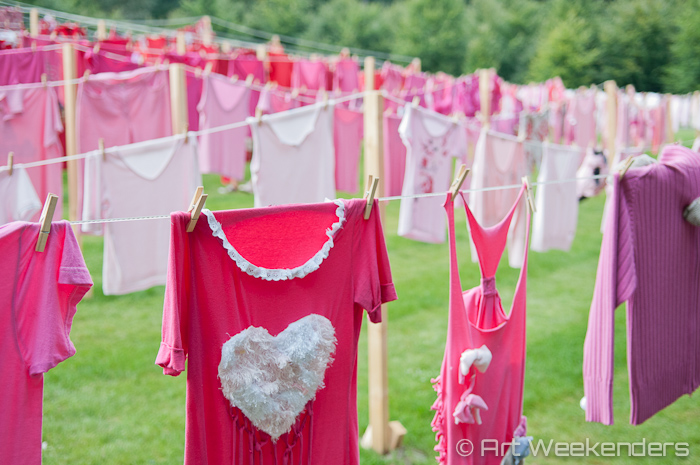
The Circle of Clothing by Pet van de Luijtgaarden
Just at this occasion the exhibitions on show included ‘Seurat: Master of pointillism’. ‘Seurat’s Followers’, ‘Simon Starling – Blue, Red, Yellow, Djungel’ and ‘Ger van Elk – Flatscreens’. On top of it, out in the sculpture park there were several live events going on and the thought-provoking ‘The Circle of Clothing’ exhibition.
Out in the free in the Hoge Veluwe
Once you’re done inside (and even if you’re not, at 5 pm it’s time to find the exit), the day isn’t over. Are you lucky enough and the weather is nice you are in for a treat. The Hoge Veluwe National Park is there to explore on your own. What better even, the park provides free bikes, to be used all across the park, leave on the roadside, in the park, for catching your bus, or for finding your car that you parked somewhere. Just as you please.
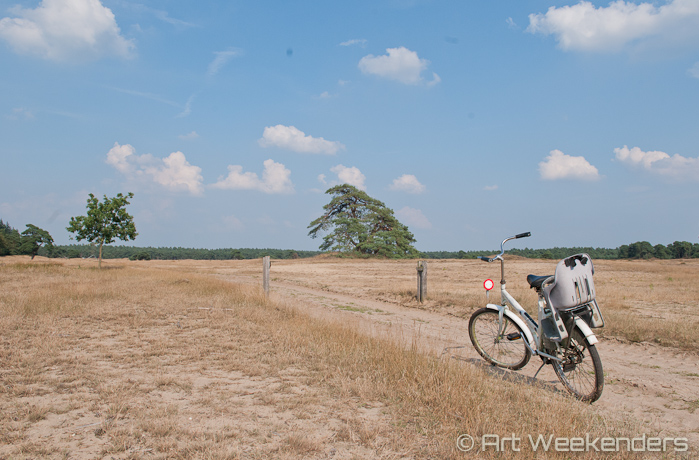
Cycling in the Hoge Veluwe National Park.
This park is a remnant of the latest ice age, and while it has an icy past occasionally it actually reminds you more of a hot desert. The sand dunes spread out are beautiful and somehow out of place and the rest of the park with the lush green all around is just as spectacular. And then they say that it’s in the autumn that the colours are really coming out…it sounds just like an invitation for going back soon again.
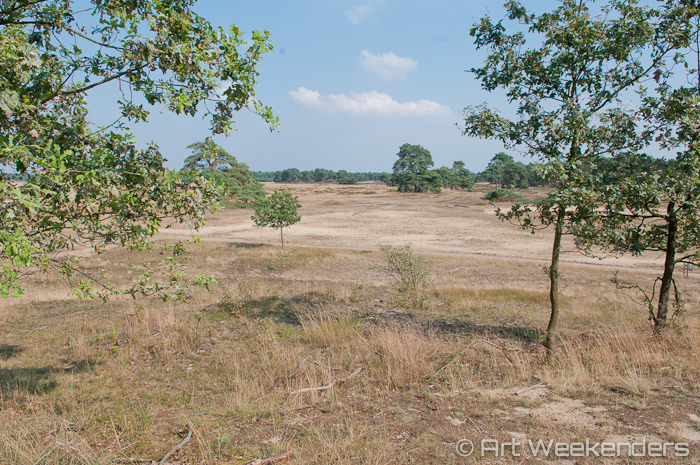
National Park Hoge Veluwe
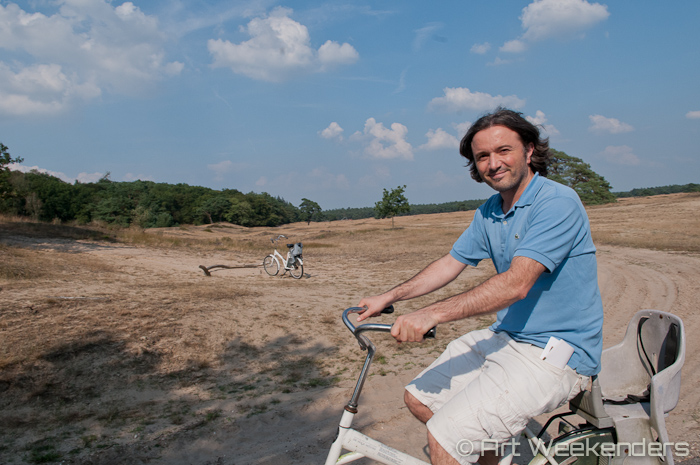
Pal cycling the Hoge Veluwe National Park
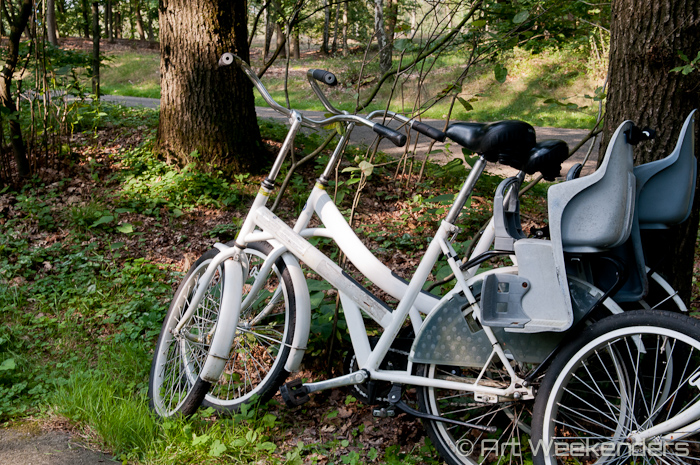
Cycling the Hoge Veluwe National Park
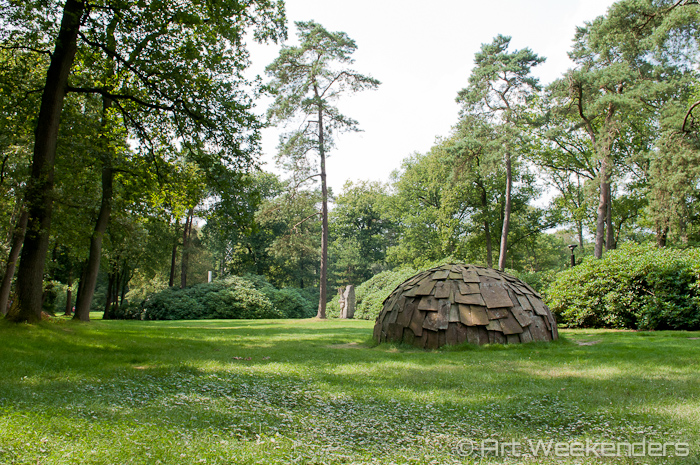
Igloo di pietra by Mario Merz
Practical Information
- The museum is open every day from 10 am to 5 pm with the exception of Mondays. The sculpture garden closes at 4:30 pm.
- The museum is situated in the middle of the Hoge Veluwe National Park, thus the only way in is by purchasing the entrance fee to the park. The day ticket for the museum and park costs € 17.40 for adults and € 8.70 for children 6-12. Only park entrance costs € 8.70.
- Dutch Museumkaart is valid and thereby entrance is free (but not to the park).
- Parking inside the park costs an additional € 6.20 and outside the park € 3.00.
- There are free bikes everywhere – as soon as you step into the park really.
- There are three motorways – A1, A50, and A12 – to the park and three points of entry: at Schaarsbergen ( Koningsweg 17), Hoenderloo ( Houtkampweg 13) and at Otterlo ( Houtkampweg 9). It is advisable to study the map before you get there so you have an idea where to go, after all you’re out in nature here.
- There are bus services from Apeldoorn and Ede/Wageningen train station every day throughout the year. The bus stops immediately outside the centre and the museum. It isn’t complicated, but you do need to think it over before-hand, and unfortunately, it takes some time to come here. For instance from Amsterdam between 90 minutes to two hours). Always plan ahead with 9292.nl. Smooth and easy. The train fare is € 16.60 one way with chip card from Amsterdam.
- Time, plan in a lot of it, especially if it’s your first visit. We’ve spent three hours and it was not even close to be enough.
The other contributions for this month’s Art Smart Roundtable are:
- Jenna of This Is My Happiness –An Art Day in Napa Valley
- Erin of A Sense of Place – An Art Day in Cambridge, MA: Modernist Architecture at Harvard and MIT
- Ashley of No Onions Extra Pickles – An Art Day in Doha, Qatar
- Christina of Daydream Tourist – Masterpieces for Free: An Art Day in Washington, DC
- Murissa of Wanderfull Traveler – An Art Day in Paris: My Own Accidental Walking Tour
- Alexandra of ArtTrav – An art day in Maremma at Daniel Spoerri’s garden
